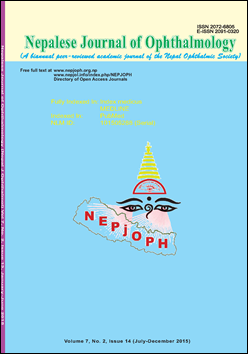Comparing biometry in normal eyes of children with unilateral cataract/corneal disease to age-matched controls
DOI:
https://doi.org/10.3126/nepjoph.v7i2.14959Keywords:
Ocular biometry, central corneal thickness, anterior chamber depth, lens thickness, vitreous chamber depthAbstract
Objective: To compare ocular biometry and central corneal thickness of unaffected healthy eyes of pediatric patients with monocular cataracts/corneal opacities and age- matched controls.
Materials and methods: We studied 329 eyes of 329 children who were between 1 and 12 years old. The study group (n: 164) consisted of healthy fellow eyes of children operated for unilateral congenital/traumatic cataract and corneal laceration. Axial length, anterior chamber depth, lens thickness, vitreous chamber depth, and central corneal thickness were measured by ultrasound biometry/ pachymetry.
Results: Axial length was 22.16 mm in the study group and 21.99 mm in the control group. Anterior chamber depth, lens thickness, and vitreous chamber depth results were 3.35; 3.64 and 15.20 in the treatment group and 3.20; 3.63, and 15.15 mm in the control group, respectively. The axial length and all the components, i.e. anterior chamber depth, lens thickness, and vitreous chamber depth are higher in the unaffected healthy eyes of the pediatric patients than that of the control group but only the difference in the anterior chamber depth was statistically significant. The central corneal thickness was 548 microns and 559 microns in the study and the control groups, respectively, and the difference was found to be significant.
Conclusion: Greater anterior chamber depth was chiefly responsible for the overall increase in the axial length in the study group. The central corneal thickness was significantly thinner in the study group than that of the control group.
Downloads
Downloads
Published
How to Cite
Issue
Section
License
This license enables reusers to copy and distribute the material in any medium or format in unadapted form only, for noncommercial purposes only, and only so long as attribution is given to the creator.




